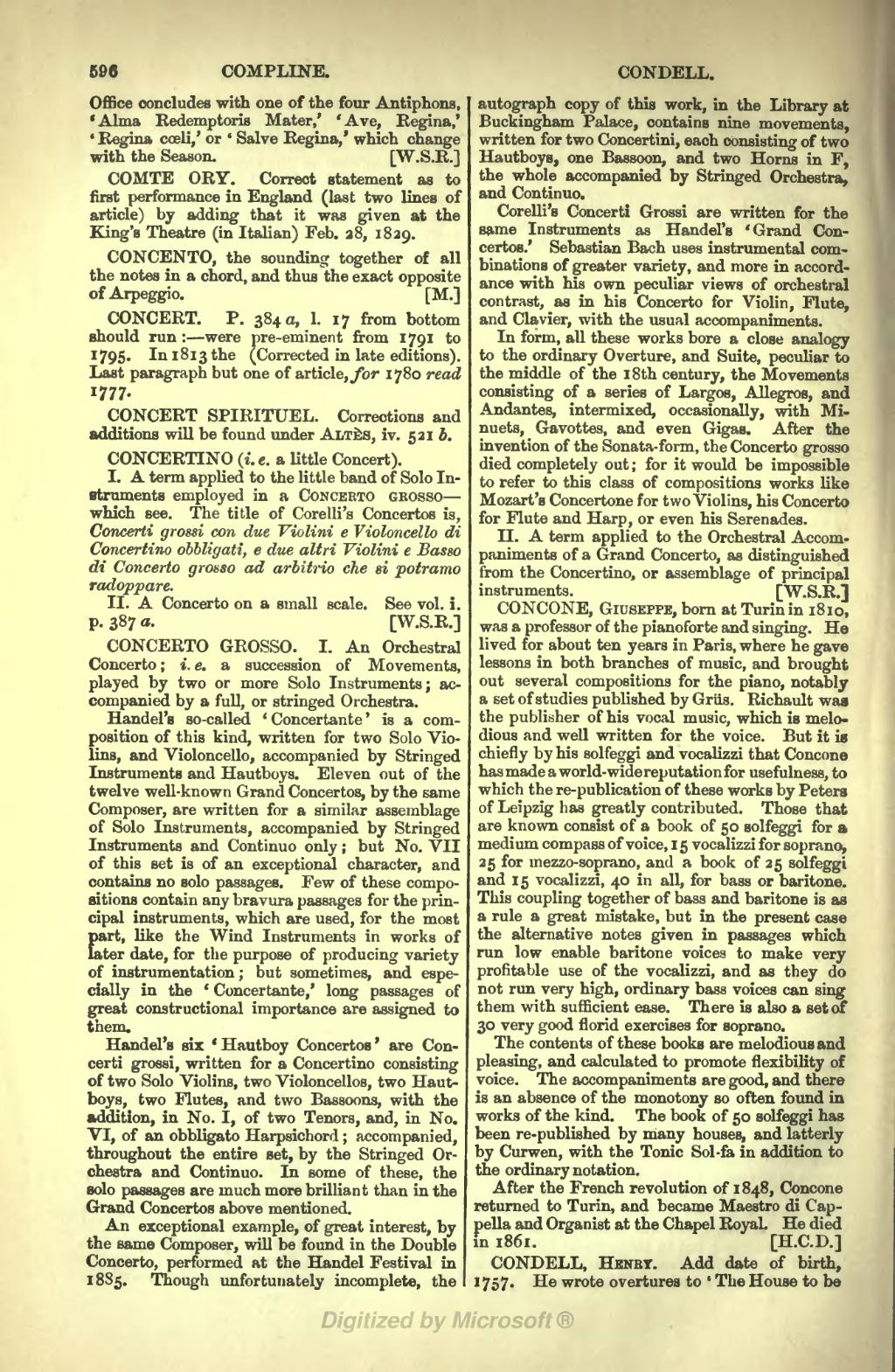Office concludes with one of the four Antiphons, 'Alma Redemptoris Mater,' 'Ave, Regina,' 'Regina coeli,' or 'Salve Regina,' which change with the Season.
COMTE ORY. Correct statement as to first performance in England (last two lines of article) by adding that it was given at the King's Theatre (in Italian) Feb. 28, 1829.
CONCENTO, the sounding together of all the notes in a chord, and thus the exact opposite of Arpeggio.
CONCERT. P. 384 a, l. 17 from bottom should run:—were pre-eminent from 1791 to 1795 . In 1813 the (Corrected in late editions). Last paragraph but one of article, for 1780 read 1777.
CONCERT SPIRITUEL. Corrections and additions will be found under Altés, iv. 521 b.
CONCERTINO (i. e. a little Concert).
I. A term applied to the little band of Solo Instruments employed in a Concerto Grosso—which see. The title of Corelli's Concertos is, Concerti grossi con due Violini e Violoncello di Concertino obbligati, e due altri Violini e Basso di Concerto grosso ad arbitrio che si potramo radoppare.
II. A Concerto on a small scale. See vol. i. p. 387 a.
CONCERTO GROSSO. I. An Orchestral Concerto; i. e. a succession of Movements, played by two or more Solo Instruments; accompanied by a full, or stringed Orchestra.
Handel's so-called 'Concertante' is a composition of this kind, written for two Solo Violins, and Violoncello, accompanied by Stringed Instruments and Hautboys. Eleven out of the twelve well-known Grand Concertos, by the same Composer, are written for a similar assemblage of Solo Instruments, accompanied by Stringed Instruments and Continuo only; but No. VII of this set is of an exceptional character, and contains no solo passages. Few of these compositions contain any bravura passages for the principal instruments, which are used, for the most part, like the Wind Instruments in works of later date, for the purpose of producing variety of instrumentation; but sometimes, and especially in the 'Concertante,' long passages of great constructional importance are assigned to them.
Handel's six 'Hautboy Concertos' are Concerti grossi, written for a Concertino consisting of two Solo Violins, two Violoncellos, two Hautboys, two Flutes, and two Bassoons, with the addition, in No. I, of two Tenors, and, in No. VI, of an obbligato Harpsichord; accompanied, throughout the entire set, by the Stringed Orchestra and Continuo. In some of these, the solo passages are much more brilliant than in the Grand Concertos above mentioned.
An exceptional example, of great interest, by the same Composer, will be found in the Double Concerto, performed at the Handel Festival in 1885. Though unfortunately incomplete, the autograph copy of this work, in the Library at Buckingham Palace, contains nine movements, written for two Concertini, each consisting of two Hautboys, one Bassoon, and two Horns in F, the whole accompanied by Stringed Orchestra, and Continuo.
Corelli's Concerti Grossi are written for the same Instruments as Handel's 'Grand Concertos.' Sebastian Bach uses instrumental combinations of greater variety, and more in accordance with his own peculiar views of orchestral contrast, as in his Concerto for Violin, Flute, and Clavier, with the usual accompaniments.
In form, all these works bore a close analogy to the ordinary Overture, and Suite, peculiar to the middle of the 18th century, the Movements consisting of a series of Largos, Allegros, and Andantes, intermixed, occasionally, with Minuets, Gavottes, and even Gigas. After the invention of the Sonata-form, the Concerto grosso died completely out; for it would be impossible to refer to this class of compositions works like Mozart's Concertone for two Violins, his Concerto for Flute and Harp, or even his Serenades.
II. A term applied to the Orchestral Accompaniments of a Grand Concerto, as distinguished from the Concertino, or assemblage of principal instruments.
CONCONE, Giuseppe, born at Turin in 1810, was a professor of the pianoforte and singing. He lived for about ten years in Paris, where he gave lessons in both branches of music, and brought out several compositions for the piano, notably a set of studies published by Grüs. Richault was the publisher of his vocal music, which is melodious and well written for the voice. But it is chiefly by his solfeggi and vocalizzi that Concone has made a world- wide reputation for usefulness, to which the re-publication of these works by Peters of Leipzig has greatly contributed. Those that are known consist of a book of 50 solfeggi for a medium compass of voice, 15 vocalizzi for soprano, 25 for mezzo-soprano, and a book of 25 solfeggi and 15 vocalizzi, 40 in all, for bass or baritone. This coupling together of bass and baritone is as a rule a great mistake, but in the present case the alternative notes given in passages which run low enable baritone voices to make very profitable use of the vocalizzi, and as they do not run very high, ordinary bass voices can sing them with sufficient ease. There is also a set of 30 very good florid exercises for soprano.
The contents of these books are melodious and pleasing, and calculated to promote flexibility of voice. The accompaniments are good, and there is an absence of the monotony so often found in works of the kind. The book of 50 solfeggi has been re-published by many houses, and latterly by Curwen, with the Tonic Sol-fa in addition to the ordinary notation.
After the French revolution of 1848, Concone returned to Turin, and became Maestro di Cappella and Organist at the Chapel Royal. He died in 1861.
CONDELL, Henry. Add date of birth, 1757. He wrote overtures to 'The House to be
